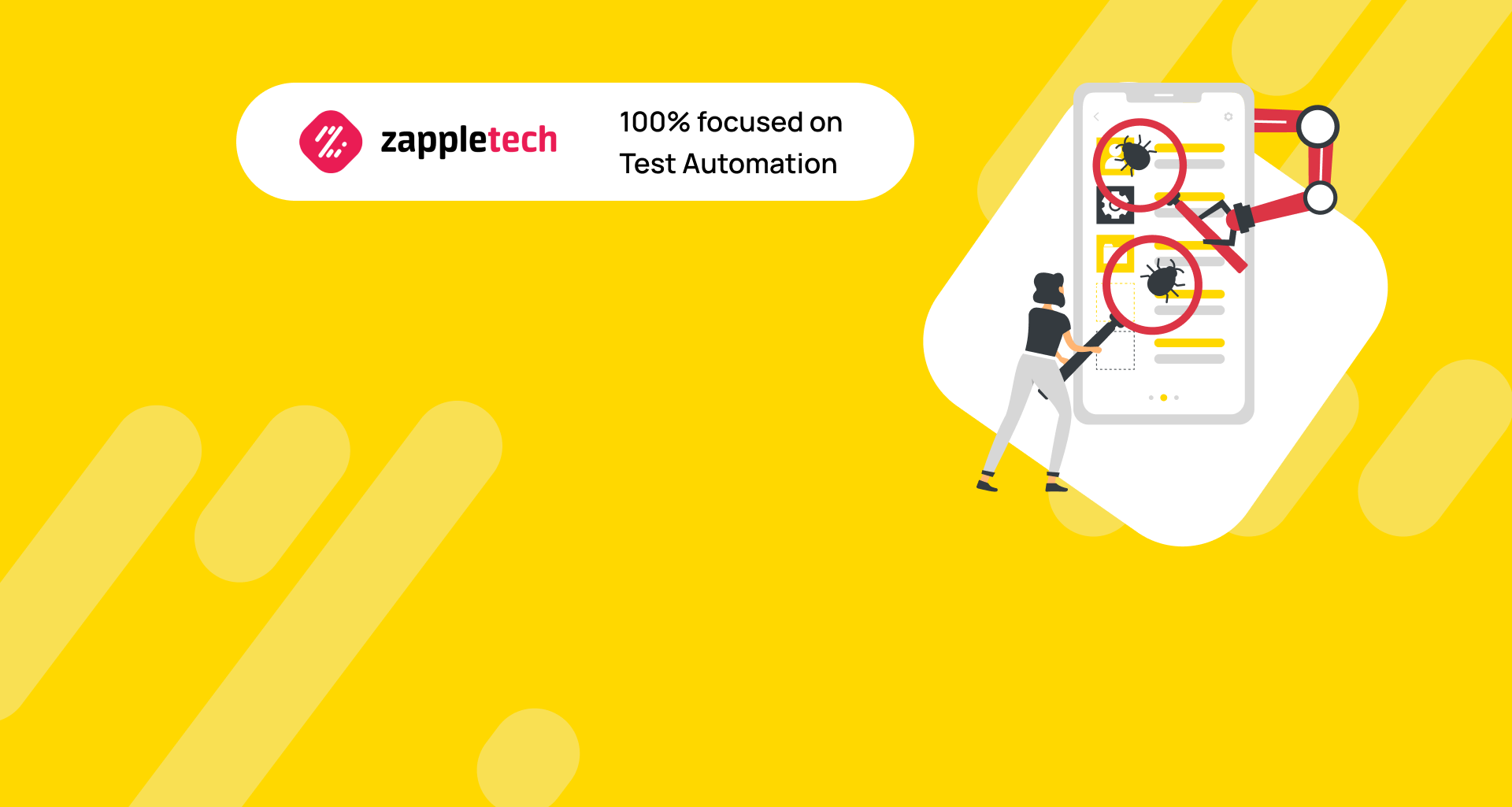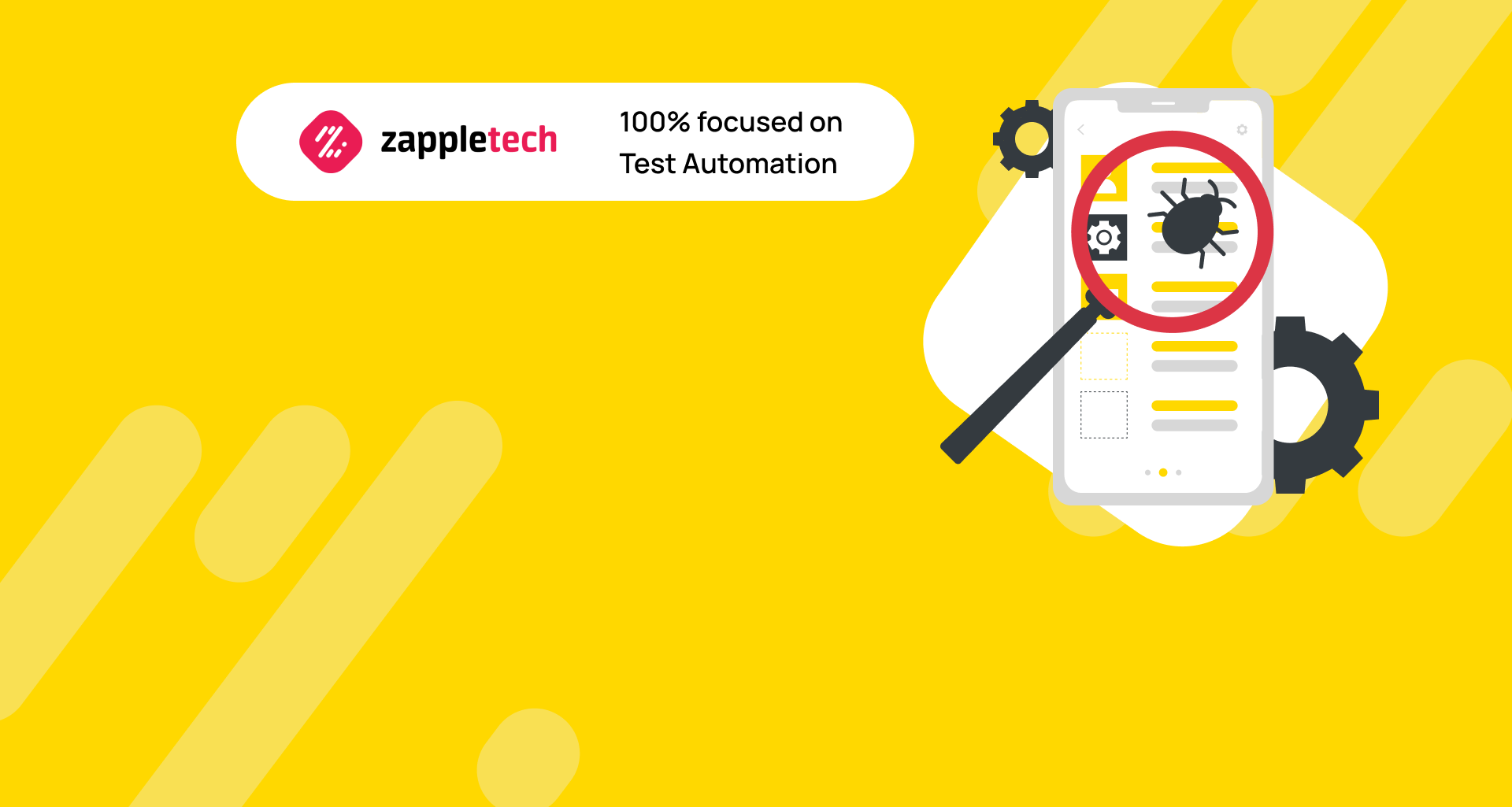Want your software product to be on top of the market? — Then there must be no errors or bugs in it, period. And what can ensure you and your future customers in its quality and worthiness? — No other than the pre-release software testing.
Testing is the final stage in any software product development. It is absolutely necessary as it allows detecting errors or bugs in the end product, further fix them, and finally, present the best, error-free version of your app or program to your target users.
Thanks to timely testing of new versions of software or apps, they can remain functional and thus demanded. That’s why this stage of software development must be treated especially carefully, and never ignored! The program which is full of bugs or errors becomes a piece of waste in the market, and unless its shortcomings get eliminated, it will be destined to eventually die…
“Testing, – you might say, – okay, but it’s not so simple, as there are different types of it, and I don’t know which to choose”. Well, software testing can mainly be of two types: manual and automated. This article will be fully dedicated to an explanation of what each of these types exists for, and the key differences between manual testing and automation testing. As only by knowing which type of testing for which test tasks is most suitable, it is possible to make the conscious decision on the testing to choose and pay for, correspondingly.
Balance is key! Use manual testing when you need that human touch—especially for early-stage exploration and fine-tuning the user experience. Then, lean on automation testing for speed, consistency, and broad test coverage, especially as your project grows. Combining both gives you the best of both worlds—catching bugs faster, improving software quality, and delivering top-notch user experiences—all while keeping your sanity intact!Mykhailo PoliarushCEO, ZappleTech Inc.
In this article, we delve into the core disparities between manual testing and automation testing, elucidating their respective strengths, weaknesses, and the scenarios in which they excel. By grasping the fundamental differences, development teams can make informed decisions, strategically leveraging both methods to achieve comprehensive testing coverage and accelerate the software development lifecycle. Let’s embark on this exploration to demystify the contrasting realms of manual and automation testing.
Table of Contents
Manual Testing
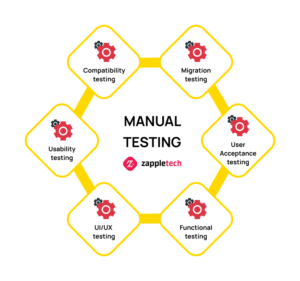
Manual testing and automation testing represent two divergent approaches to ensuring software quality, each with distinct characteristics and advantages. Let’s delve into the essence of manual testing and discern its fundamental disparities from automation testing.
Manual testing, as the name suggests, relies on human intervention to execute test cases, analyze results, and ensure software functionality. Unlike its automated counterpart, manual testing involves testers meticulously navigating through the software’s features, evaluating its behavior, and validating it against predefined criteria.
One of the primary distinctions between manual testing and automation testing lies in the level of human involvement. Manual testing offers testers the flexibility to adapt their approach based on intuition, experience, and real-time feedback. This hands-on approach enables testers to identify subtle nuances, edge cases, and user experience issues that automated scripts may overlook. Moreover, manual testing is invaluable in scenarios where exploratory testing is necessary, allowing testers to uncover unforeseen defects and evaluate the software’s usability from an end-user perspective.
Another key aspect of manual testing is its suitability for early-stage and exploratory testing. During the initial phases of software development, when requirements are evolving, manual testing provides the agility to test quickly and iteratively. Testers can easily adjust test cases, explore different test scenarios, and provide immediate feedback to developers, facilitating rapid bug identification and resolution.
Manual software testing is a type of software testing where the one and only testing executor is a QA Analyst or, as the specialist is often referred to, a human tester, and it’s where the first difference between manual and automation testing lies. This QA specialist performs all the test cases put in charge of him manually, step by step, without the help of any tools or scripts for testing automation, nor does he write those scripts on his own.
Companies usually refer to manual testers when it’s needed to check the work of all the key features of a certain application and find any possible bugs in it. The type of testing where the goal is to discover unknown and unexpected errors or bugs is called exploratory testing, and only manual testing is suitable for this purpose, and it’s another difference between manual and automation testing. This type of testing is especially valuable before the app or program’s first release.
Other tasks or objects for testing where only manual, or in other words, human testing can cope with are UX and UI of applications or desktop programs. As only a human mind can judge on user-friendliness or handiness of a program or app.
Manual testing is performed manually by humans without the help of any algorithms to automate the process, thus it can take quite much time. Because of this, the efficiency and test coverage in manual testing are comparatively low. In addition to it, due to that, the test performers are humans, human mistakes are possible.
Manual testing is like having your own detective, perfect for uncovering those hidden bugs and ensuring your software works just right. It’s hands-on, flexible, and great for evaluating the user experience. Don’t forget to give it the attention it deserves.Mikhail BodnarchukCDO, ZappleTech Inc.
Automated Testing
Automated testing stands as a pivotal paradigm in modern software development, offering a systematic approach to verifying software functionality and ensuring its quality. Let’s explore the essence of automated testing and uncover the key disparities between manual and automation testing.
Unlike manual testing, which relies on human intervention to execute test cases, automated testing leverages specialized tools and scripts to automate the validation process. This shift from human-centric to machine-driven testing brings forth several distinct advantages, chiefly efficiency, repeatability, and scalability.
One of the primary distinctions between manual testing and automation testing lies in efficiency. Automated testing allows for the rapid execution of test cases across different platforms, configurations, and environments, significantly reducing the time and effort required for testing. Through the creation of test scripts, repetitive test scenarios can be executed with precision and consistency, enabling testers to focus their efforts on more complex and critical aspects of the software.
While manual testing is conducted by human testers on their own, without the help of any automating tools, automated testing is performed mostly without the participation of humans. This type of testing is conducted with the help of scripts and tools that automate the process of testing. Humans also take part in automated testing, but their function in it is about writing testing scripts that automate the execution of tests.
Automated testing is mostly used for repetitive test cases, for checking if features work as expected. For example, it is typically used for maintaining the stable functional which stays the same, or to check whether the newest changes have somehow damaged it.
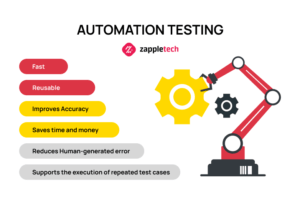
This type of testing is also often used in complex checks which are hard or time-consuming to perform manually.
Among the obvious advantages of automated testing is that they are free from errors due to they’re executed not by humans, but by scripts. Another advantage of this type of testing is that it takes substantially less time than manual testing.
At the same time, despite the automation, this type of testing requires more technical skills and the knowledge of programming languages, than in the case with the manual one.
While automated testing presents numerous advantages, it is not without its limitations. Unlike manual testing, which offers the flexibility to adapt test scenarios on the fly, automated testing requires meticulous script development and maintenance. Test scripts must be regularly updated to accommodate changes in the software, which can be time-consuming and resource-intensive. Additionally, automated testing may struggle to effectively validate certain aspects of the software, such as visual elements, usability, and subjective user experiences, which often require human judgment and intuition.
In essence, automated testing complements manual testing by offering efficiency, repeatability, and scalability, thus streamlining the testing process and enhancing software quality. By strategically integrating automated testing into the testing lifecycle, organizations can achieve faster feedback cycles, mitigate risks, and deliver high-quality software solutions that meet the demands of today’s fast-paced development environments.
Automation testing is like having a speedy assistant—it’s all about efficiency and consistency. Let it handle repetitive tasks and keep your testing process running smoothly. It’s a real time-saver.Sergey AlmyashevCOO, ZappleTech Inc.
The Summary on Differences Between Manual and Automated Testing
Manual and automated testing, of course, have something in common. Both manual and automation testing have one end purpose — to tell developers where problems in the new software or mobile app are, to further fix those, and release the best possible quality product.
Still, as the above-written brief resumes on each of those show, the approaches of manual testing and automation testing differ very much. So, it’s reasonable to further provide a list of key differences between manual and automated testings, to never ever mix those up and just better differentiate between manual and automation testing!
The key differences between manual and automated testing are put in the table below:
Manual testing | Automated testing | |
By whom is executed | Human tester | Scripts, tools for testing automation |
Purpose of testing | To discover any bugs and/or errors in the software of an app | To “say” if the software works as expected or not. If not, then there must be bugs/errors. |
Requirements to testers | An experienced and highly professional specialist | Even higher expertise than in the case with manual testing is needed: the knowledge of programming languages and testing script writing is required. |
Does it take much time? | Yes. | No (it takes sufficiently less time compared to manual testing) |
The possibility of mistakes | As it is performed by a human, mistakes can happen. | No mistakes are possible, the testing is more reliable. |
It’s obvious that each type of testing has its weaknesses, but at the same time is about certain strong advantages that could be put to good use. To never mistake in choosing the type of testing needed for a certain case, it’s nice to have a summary of the cons and pros of each type of testing. Moreover, those pros and cons allow us to better see the difference between manual testing and automation.
Pros and Cons of Manual Testing
Pros
- It is less expensive compared to Automated testing, as no specific tools for test automation are needed
- No coding knowledge is required
- Human intuition, vision, and judgment help in deciding on an app’s or program’s UI or UX, and automated testing cannot compete with those
- Getting accurate and fast visual feedback
Cons
- It’s more time-consuming compared to the automated testing
- As it’s conducted by a human, it’s prone to human mistakes and thus the results of manual testing can be less reliable
- Manual testing cannot be replicated, nor can it be recorded, and it’s another key difference between manual and automation testing
- Compared to automated testing, it’s of less test coverage
- A human tester can get tired and bored
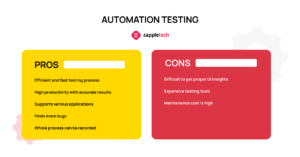
Pros and Cons of Automated Testing
Pros
- As compared to manual testing, it can find more errors or bugs in the software
- It’s fast
- More tests can be done in unit time
- It’s fast and more efficient in terms of future testings: as its process can be recorded and thus reused many times further
- No one gets tired of automated testing, as the special software instruments are occupied with it
Cons
- With the help of automated testing, it’s impossible to get any insights into the software or app’s convenience and visual attractiveness
- The tools for automated testing can be very expensive which can make the project costlier than in the case with the manual testing
- Automation tools can have certain limitations and bugs as well
- It’s thus necessary to debug automated test scripts before their usage. This may require additional expenses.
Importance of Automation Testing and Manual Testing
Manual Testing and Automation Testing each play vital roles in today’s software development landscape, offering distinct advantages that contribute to the overall quality and success of software projects.
Importance of Manual Testing:
Human Insight and Intuition: Manual testing harnesses the cognitive abilities of human testers to identify nuanced issues that automated scripts may overlook. Testers can leverage their intuition and experience to explore the software from an end-user perspective, uncovering usability issues, and providing valuable feedback for improvement.
Flexibility and Adaptability: In rapidly evolving development environments, manual testing provides the flexibility to adapt test cases and strategies on the fly. Testers can quickly respond to changing requirements, explore edge cases, and perform ad-hoc testing to validate software functionality, ensuring thorough test coverage throughout the development lifecycle.
Early Stage and Exploratory Testing: During the early stages of development when requirements are fluid, manual testing allows for quick iteration and validation of software features. Testers can perform exploratory testing to uncover unforeseen defects and assess the software’s usability, helping to refine requirements and improve the overall quality of the software.
User Interface (UI) and User Experience (UX) Evaluation: Manual testing is essential for evaluating the software’s UI and UX design, as well as its usability and accessibility. Human testers can assess visual design elements, navigation flows, and user interactions, ensuring that the software meets the expectations and preferences of end-users.
Importance of Automation Testing:
Efficiency and Time Savings: Automation testing accelerates the testing process by executing test cases rapidly and consistently across multiple platforms, configurations, and environments. By automating repetitive test scenarios, organizations can significantly reduce testing time and effort, enabling faster delivery of high-quality software.
Repeatability and Consistency: Automated tests provide consistent and reliable results, ensuring that the same set of tests is applied uniformly to each software build. This repeatability enhances the reliability of test results, facilitates early defect detection, and enables efficient regression testing to maintain software stability across iterations.
Scalability and Continuous Integration: Automation testing offers scalability to handle large test suites, complex test scenarios, and continuous integration and delivery pipelines seamlessly. Automated tests can be integrated into the CI/CD process, enabling organizations to achieve faster feedback cycles, identify issues early, and deliver software updates more frequently with confidence.
Comprehensive Test Coverage: With automation testing, organizations can achieve broader test coverage, including regression testing, performance testing, and load testing, which may be impractical to perform manually. Automated tests can cover a wide range of use cases and edge conditions, ensuring comprehensive validation of the software’s functionality, performance, and security.
In summary, both manual testing and automation testing are crucial in today’s software development landscape. While manual testing offers human insight, adaptability, and usability evaluation, automation testing provides efficiency, repeatability, scalability, and comprehensive test coverage. By strategically combining both approaches, organizations can optimize their testing efforts, mitigate risks, and deliver high-quality software solutions that meet the demands of modern development environments.
Difference Between Manual Testing And Automation Testing: Conclusion
Software testing is a beautiful thing that allows eliminating any problems with the software before its release to the public. Either manual or automated testing can perform this function to the fullest, still, there are certain specifics in each of these types of testing.
Manual testing requires more time, its results can also be about discovering new bugs or errors and include insights about the look and feel of the tested product as well.
Automated testing, on the other hand, can be executed way faster and be of zero fatigue of testers as the test is conducted by scripts. But though testers involved in automated testing, get less tired of the testing process, they need to be much more expertised in programming and testing scriptwriting than manual testers do.
Automated testing is also about the opportunity of replication of tests, and executing more test tasks per unit time, and thus, more test coverage. Still, though scripts accomplish tests speedier, they cannot bring any reasonable insights on the software’s design or handiness: human intuition and vision are necessary for that!
So, should you need to accomplish a series of tests in a short time, and your future testing is of the new version of an already existing application, you’d better opt for the automated testing. If you’re going to test the unreleased yet new application or desktop program, trust its testing first to an experienced manual tester. Let him discover something unexpectedly glitchy about your app, and of course, give credence to his views about your product’s look and feel!
